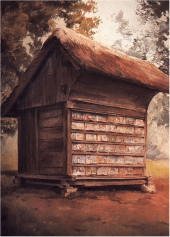Recently posted an article on Windward.org about the roundwood Bee hut and associated pollinator garden. Below is a passage from the article, but you can read the full several page article at:
http://windward.org/2.0/notes/2015/2015andrew05.htm
For several years we've been dreaming up a way to incorporate our bees closer into our primary food forest space in a way that would not put people in this high-traffic area at risk of upsetting the bees.
This spring we began construction of a "bee hut" - a structure designed to provide shelter for various honey bee hives.
The bee hut is located in a quiet corner of our zone-2 garden, in an area we are developing a pollinator garden intended to provide good sources of nectar and pollen for the honey bees and various other native pollinators which service our expanding agroforestry systems.
Seven Stevens (sevensplace.com) and Sarah Mapelli (SaramMapelliBeeQueen.com/) AKA "Tink" helped us with the design and implementation of the bee hut, the sitting bench and windbreak designs. Both Seven and Tink are passionate about bees, and have lots of experience with natural and conventional building. There thoughts and perspectives really helped to make this whole project come together.
Benjamin Pixie (benjaminpixie.blogspot.com/), a self described "beekeeper, herbalist, traditional foods cook, hide tanner, crafter of and with the wild, magician, teacher and practitioner of ancestral skills" also helped us in the development and implementation of the swarm mother concept, and in understanding how to better work with the bees and swarms, and what plants might be added to the bee garden. Benjamin's knowledge of bee culture and care deepened Windward's understanding of to better work with the unique intelligence of the bees and help give them a good life on this land.






